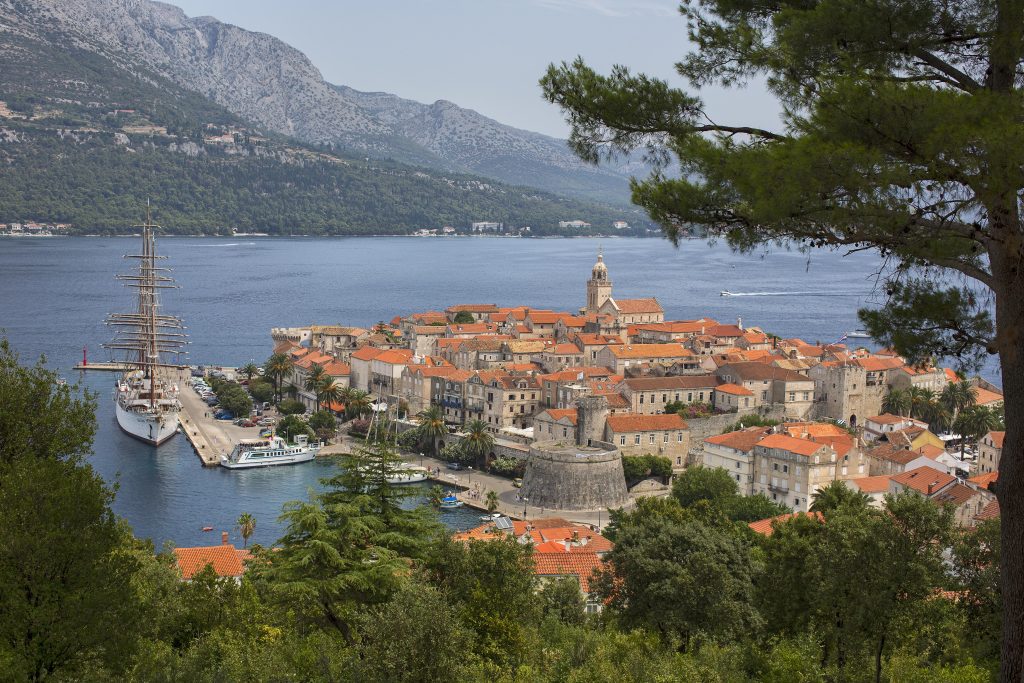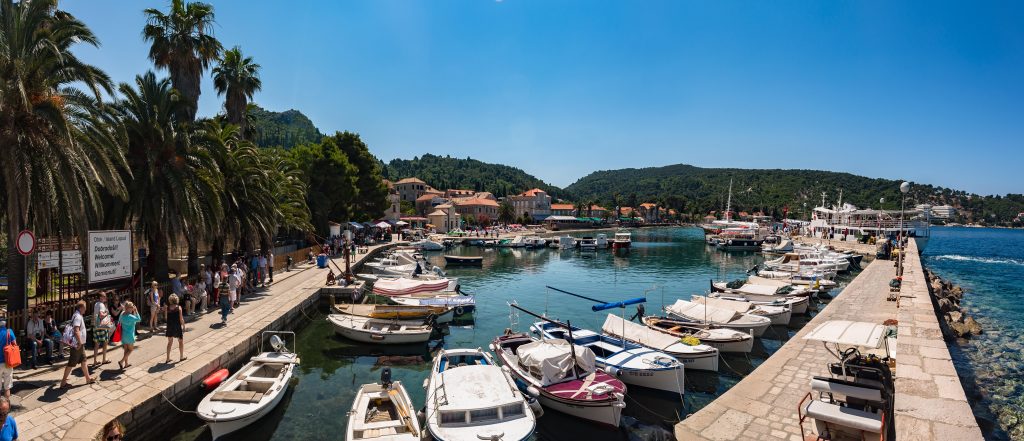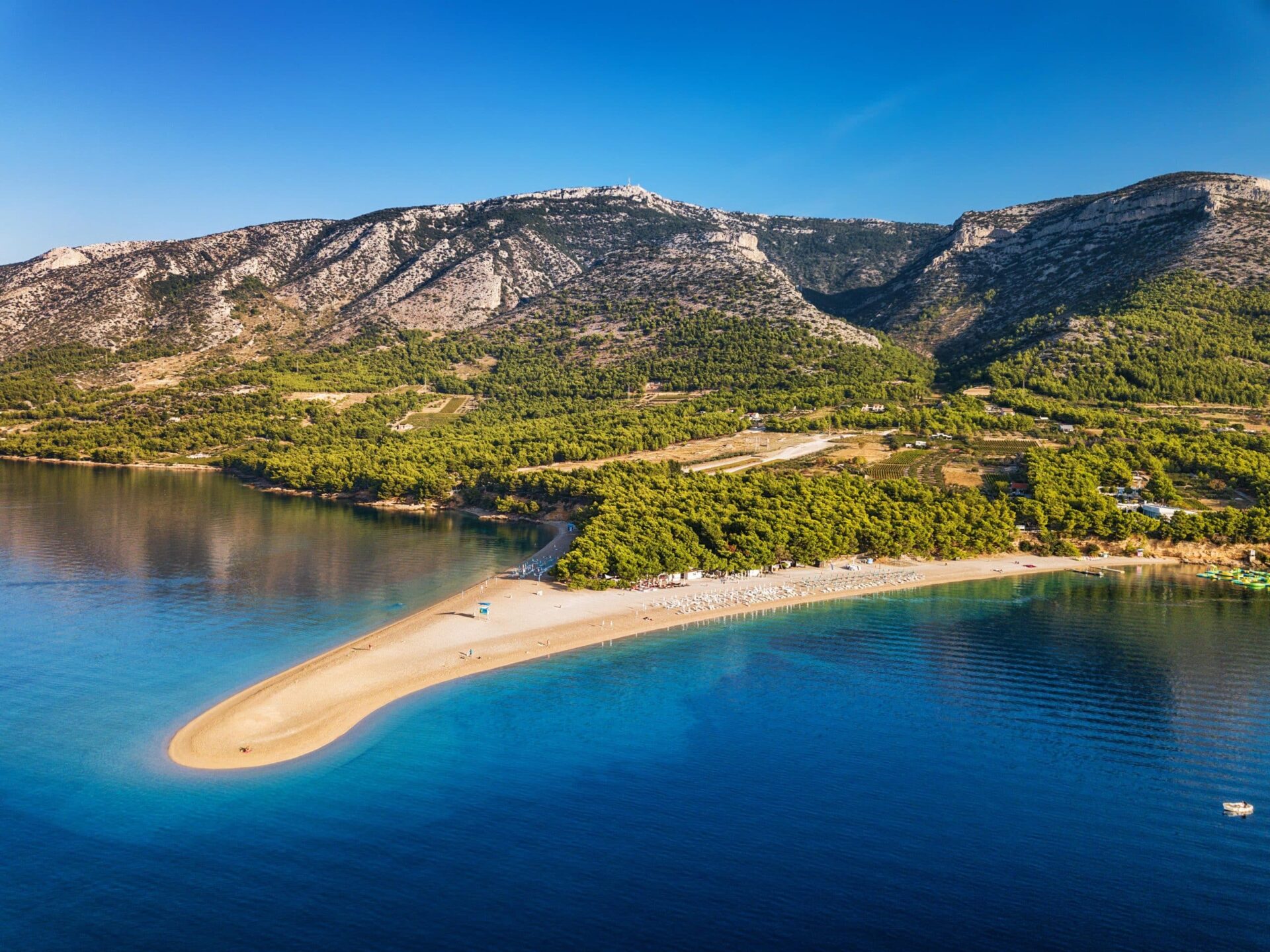The Islands Of Dalmatia, Croatia
The islands of Dalmatia in Croatia, along the Adriatic coastline, are arguably one of the most spectacular sights in Europe. For years through my work, I visited and promoted so many of these islands which combine both natural beauty and tradition with modern-day chic.
I used to regularly drive the 6 hours along the Adriatic highway from Split down to Dubrovnik and I would lose count of the number of times I would stop just to take in the breathtaking views and vistas of this rugged coastline.
The most popular islands for tourism are Brac, Korcula, Hvar, and Mljet. Other popular yet smaller options are the Elafiti islands of Sipan, Kolocep, and Lopud or the island made famous by the film Mamma Mia – Vis.
Recent years have seen many music and art festivals taking place in locations up and down the country and these attract younger audiences. Organized tours with ferry crossings included allowing you to get a taste of both the islands and the mainland. You can also take a cruise or a gulet and let a skipper navigate you along the Adriatic waters while you sip on your Croatian wine and admire the sheer beauty of the country.
All in all, the islands of Dalmatia have to be seen to be believed. You need to take your time to discover each. Enjoy the sun, the crystal clear waters, and the welcome that each offers. Do that and like me, you will forever be a fan who longs to return.
Here is my review of the islands working my way from the north of Dalmatia to the south.
Kornati Islands
The Kornati Islands are an archipelago consisting of 140 islands covering an area of 114 square miles. Many of these islands are part of the Kornati National Park due to their natural beauty, numerous coves, and crystal-clear blue waters
There are no permanent residents of the islands and the majority of the area belongs to the people of Murter island. They will visit to tend the olive groves, vineyards, and orchards. Many of them will have cottages where they stay during the agricultural season.
The islands are best visited on an organized day excursion from Zadar, Sibenik, or Split although it is possible to stay in one of the cottages for a Robinson Crusoe-type holiday.
Don’t expect many facilities though as your stay will have no electricity or running water. A boat from Murter will deliver you there and pick you up a week later. This is truly the place to get away from it all!

Brac
My memories of Brac were back at the start of this century and taking a group of travel agents to stay at the large Bluesun Hotel Elaphusa opposite the famous Zlatni Rat beach. While at that time the hotel was tired and in need of a refurbishment (it’s lovely now) I remember a great Croatian night in the traditional tavern eating pizza, drinking Karlovaco beer, and dancing to local music. Good times – Croatian times!
The island of Brac is the third largest island in the Adriatic and enjoys hot and dry summers. Famous for its lovely coves and coastline and three key towns – Bol, Postira, and Supetar.
Bol is Brac’s oldest coastal settlement with its origins dating back to the Christian era. On the south side of the island under Mount Vidova Gora is the medieval seaport. Bol town has a lovely feel about it with some narrow cobbled streets and a promenade of shops, bars, and restaurants. From this town, there is a land train that runs along the coast to probably Croatia’s most famous beach which is called the Zlatni Rat or the Golden Horn. Aside from its beauty, it is known for changing shape depending on the direction of the wind. The beach is small stones and almost gravel rather than fine sand as it may appear in the images. Behind the pathway from Bol Town to Zlatni Rat is a selection of family-orientated hotels and in the high season many stalls sell gifts and drinks, and there are some restaurants and cafes too.
Postira is a small fishing village located on the north coast and as is so often in Croatia surrounded by pine and olive trees. The village has some bars and restaurants and the nearby Lovrecina with its lovely sandy beach and sheltered cove make it an ideal bathing spot for families.
Supetar is a town with a gorgeous harbour that links the island with the mainland. Staying at the small but oh-so-friendly Hotel Villa Adriatica you can in the early evening wander along its long promenade stopping for a beer, an ice cream, or a meal before you arrive at the harbour where another drink should be the order of the day, to take in the views, the boats and to people watch.
Supetar is a special town with a unique and friendly atmosphere.
Hvar
Hvar has the X factor. I remember my first visit, in fact, my first landing in particular. We arrived by boat as the sun was setting and we were picked up from the harbour side by a friendly hotel porter in a golf buggy who was delighted to welcome tourists again. The luggage was put on the back and as we gently trundled around the harbour people were dining al fresco in pretty restaurants, there was music and there was the smell of the Adriatic on what was a warm barmy evening. The beauty and the atmosphere was unforgettable and that moment has remained with me to this day.
That evening back in 2001 we were staying at a hotel which in those days was tired with hideous purple and black decor and it was desperately in need of renovation. Today that hotel is the Amfora Hvar Grand Beach Resort & Spa and is now a 5-star exclusive hotel. Croatia has changed so much in two decades although in the outlying towns and villages, you can still discover the traditional Hvar as it once was.
Hvar is known as the “Madeira of the Adriatic” with a climate that boasts 2,715 hours of sunshine every year. For those of you who know Madeira then you will know that the comparison is drawn due to the island’s lush vegetation, pinewoods, olive groves, and numerous aromatic plants that perfume the fresh clean air. Hvar is famous for its vineyards producing countless different types of impressive wine and also for its lavender fields. Every souvenir shop will be selling little bundles of lavender to take home.
Hvar town is the main town on the island, although there are plenty of other smaller resorts and villages throughout the island. The main fortified town is now seen as a place for the rich and famous to moor their yachts and dine “al fresco” at one of the many restaurants dotted around the harbour. Hvar can be lively so prepare for a party in the main summer months. The town also boasts a Venetian palace and a perfect centuries-old theatre, the first to be built in Europe and still in use today.

Vis
Vis was one of the few Croatian islands of any size that has so far eluded me and as such, I have always had this yearning to go!
Vis is the furthest island from the Adriatic mainland and has in recent years gained increased recognition as the island where the Momma Mia sequel was filmed.
The natural vegetation of Vis means it is ideal for those who love the great outdoors as the region is covered in pine trees, carob trees, and citrus orchards as well as exotic species such as palm trees, cacti, and rare silver palm trees. Much of the island is devoted to vineyards that produce the famous white wine, “Vugava” and the red wine “Plavac” to which I am rather partial!
One day I hope to get there and tell you a whole lot more!

Korcula Island
I have always loved the feel of Korcula as it has that real magic and air of history about it. I always stayed at the Marko Polo Hotel with terrific views across to the old town and also across to the mainland.
Korcula, the birthplace of Marco Polo and often referred to as a mini Dubrovnik, is one of the largest of the Adriatic islands with over 195 unspoiled coves and beaches and an old town full of charm and character. It is easily accessed by a short ferry from Orebic on the Peljesac Peninsula. The image of Korcula’s old town is one of the most popular images used to showcase the country of Croatia!
The island will appeal to those who enjoy their active pursuits. There are pine-scented woods and caves to explore, numerous water sports and activities to take part in, plus a selection of little bars, restaurants, and coffee shops to while away those hot steamy days and barmy nights.
Korcula also has a very proud tradition and one of the Adriatic’s most unusual customs – the Moreska sword dance. It probably began in Spain as a form of protest against the Moorish occupation and then migrated to Korcula in the 15th century. It is effectively a danced version of a sword battle and tells the story of an abducted princess. My advice is to stand well back and take cover behind someone bigger than you!
Korcula is for everyone – families, couples, and those who like to get out and about.

Lastovo Island
Lastovo is where you can taste some of the finest lobster in the region. Albeit a distant island from Dubrovnik, a visit is well worth the effort. Try to visit at Carnival time, as Lastovo’s unusual carnival traditions are among the best known in Croatia.
Lastovo is for the adventurous and for those who want to switch off and relax.
Mljet Island
Now I am a fan of Mljet but then when you hear that it’s all about nature, peace, quiet, and scenery you will know why! Thought by many to be one of the most beautiful islands on the Adriatic I visited it way back in the late nineties. I recall the scent in the air of pine trees and pretty lakeside walks where elderly ladies sell figs, honey, and olives at makeshift stalls.
Mljet is a national park with two lakes, Malo and Veliko. Within one of those lakes is home to a tiny island called St Mary and a Benedictine monastery that bizarrely sells some of the best ice creams I have ever tasted – funny what you remember!
All over Mljet are a crisscross of paths often lined with locals selling honey or olives or oils. I always think of Mljet as an ideal place to go if I ever wanted to just switch off and reflect – maybe even write my travel blog – it is so peaceful and full of forest, attractive shorelines, and a few hills to keep you fit and then, of course, you have those lakes.
I stayed at the Hotel Odisej which is the only hotel on the island although there is a small selection of villas and apartments. It’s not a place for the family however I am probably saying that because I don’t want screaming kids in this little corner of paradise – just me, nature, and that ice cream!

Sipan Island
Sipan is the most populated and largest of the Elafiti islands at 9 km long by 2.5km wide. There are two main villages Sipanski Luka and Sudurad where there are the ruins of a castle and palace as well as 30 churches dating back to the middle ages.
Most people staying on Sipan go for the peace, the excellent homegrown hospitality, and the opportunity to explore on foot via a choice of well-marked hiking trails. Way back in early 2000, I stayed at the Hotel Bozica which is a lovely quality hotel in a great location overlooking a secluded and charming bay in Sudurad. Dubrovnik is accessible by ferry from Sipan making a two-centre stay an attractive option.
Sipan has a magic to it that is very appealing to many UK guests who just want to switch off relax and enjoy local food, wine, and hospitality.
Sipan is perfect for couples looking to relax or on a family holiday without the modern-day frills.
Lopud Island
A small and peaceful island renowned for its warm and sunny climate as well as tropical vegetation and Mediterranean flora. The island boasts one of Croatia’s very few truly sandy beaches in the Bay of Sunj.
Lopud itself has a large promenade, a botanical garden, a profusion of flowering shrubs and trees, some bars, and a limited choice of restaurants.
My main memory of Lopud is taking a group of travel agents to the Hotel Lafodia when it was so badly damaged from the war that it was rather difficult to “sell” it to the agents. I always remember thinking as we sailed away that one day this island would prove everyone’s doubts wrong. Would love to take those same travel agents back and see what they think now! It’s glorious!
Lopud is ideal for families with children wanting that peaceful, safe, traffic-free holiday experience.

Kolocep Island
Kolocep pronounced KO LO CHEP is one of 13 islands that are part of the Elafiti. With less than 200 inhabitants and no cars, you will find the island charmingly simple.
This island is famed for its sub-tropical vegetation as well as the quaint fishing village of Donje Celo which is on the northwest coast of Kolocep and protected from the winds by a limestone ridge. The other popular beach is Gornje Celo on the southwest coast.
The “Church of Our Lady” from the 13th century is a popular attraction.
Back when I last visited the Hotel Villa Kolocep was the place to stay however it was taken over by TUI and is now exclusive to them. Otherwise, accommodation tends to be villas or apartments and of different standards.
Visitors would be families and couples looking for a peaceful relaxing holiday although I can’t say what goes on within the TUI hotel resort.
Contact Information
For further information on the islands of Dalmatia or taking a trip to any part of Croatia, either contact your local travel agent, a specialist tour operator, or the Croatia National Tourist Board.







